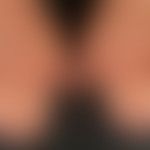Synonym(s)
DefinitionThis section has been translated automatically.
An autoimmunological multisystem disease belonging to the so-called collagenoses with varying degrees of fibrosis of the skin, subcutis and numerous other organs (vessels, lungs, intestines, skeleton, kidneys, heart, liver) as well as an obliterating angiopathy with fibrosis and obliteration of small vessels (onion-skin angiopathy with intimal proliferation) with skin and organ infarcts.
ClassificationThis section has been translated automatically.
A distinction is made between limited and diffuse forms. The so-called CREST syndrome (Calcinosis, Raynaud phenomenon, Esophageal hypomotility, Scleroderma, Teleangiectasis) is a subtype of limited systemic scleroderma and characterizes a common disease pattern.
Classification of systemic scleroderma according to disease activity:
- Acute inflammatory (malignant) systemic scleroderma with rapid progression of sclerosis, with or without organ symptoms.
- Chronic inflammatory (often vascular) systemic scleroderma with intermittent progression, with or without organ symptoms.
- Aphlegmatic systemic scleroderma, with or without organ symptoms.
- Burned-out systemic scleroderma in the final sclerotic state, without signs of activity.
- Systemic scleroderma without scleroderma (without signs of sclerosis of the skin).
Clinically, three main types are distinguished:
- Type I: Acral type (most common form with a marked vascular component).
- Type II: Proximal ascending type with ascending sclerosis of the forearms and upper arms. Involvement of the digestive tract, lungs, kidneys and liver (primary biliary cirrhosis).
- Type III: Truncal scleroderma (truncal type) with centrifugal spread. Raynaud's phenomenon may be absent. Involvement of joints and internal organs (heart, kidney, digestive tract). Febrile temperatures.
The American Rheumatism Association (ARA) distinguishes:
- Limited systemic scleroderma (sclerosis).
- Diffuse systemic scleroderma (sclerosis).
You might also be interested in
Occurrence/EpidemiologyThis section has been translated automatically.
Worldwide, common to all populations. Blacks and Hispanics are generally observed to have higher severity levels than whites.
- Incidence: 0,5-1,5/100.000 inhabitants/year
- Prevalence: 10-15/100,000 inhabitants/year.
EtiopathogenesisThis section has been translated automatically.
Systemic disease with humoral and cellular immune phenomena, e.g. depression of T lymphocytes, presence of clonal T cells (about 30% of patients), evidence of antinuclear factors.
Discussed are genetic disposition (correlation with HLA-B8, HLA-DR5), disturbance of microcirculation (initially functional, then lesions of endothelial cells), dysregulation of connective tissue metabolism (increased biosynthesis of proteoglycans and collagen).
Possibly, stimulating antibodies against the PDGF receptor (= receptor of the "Platelet-Derived Growth Factor" [see also below Growth Factors and Tyrosine Kinases]) as well as an abnormal TGF-beta signal transduction play a role; this would explain the clinical effect of the tyrosine kinase inhibitors. Furthermore, it could be shown that the chemokine CCL13 is increasingly expressed in the skin of patients with systemic scleroderma. The serum level of this chemokine (diagnostic marker) is also increased.
Silicosis and systemic scleroderma: A two- to eightfold risk of rheumatoid arthritis and systemic lupus erythematosus and a more than 24-fold risk of systemic scleroderma and ANCA vasculitis have been found in individuals with silicosis (Makol A et al. 2011) .
ManifestationThis section has been translated automatically.
Usually occurring between 30 and 50 LJ. Women are 10-15 times more frequently affected than men.
ClinicThis section has been translated automatically.
Prodromes: Uncharacteristic disturbance of general condition, acrocyanosis, livedo racemosa, sensitivity to cold in the cold season. Raynaud's phenomenon occurs in 60-90% of cases, often as the initial symptom of PSS. Type I is also called limited form, types II and III diffuse forms (in Anglo-American literature).
Skin manifestations: Acras: Raynaud's syndrome (anamnestic, possibly cold provocation), acrosclerosis(sclerodactyly), edematous swelling, hyperpigmentation, spatter-like scarring, sclerosed cuticle, pathologic capillaries on nailfold dermatoscopy (path. structures and decreased density <7 capillaries/mm), telangieectasias, hemorrhages. In the late stage, tight atrophies, sclerosis (= Hoick-Gottron sign), flexion contractures with formation of a claw hand, nail dystrophies as well as extremely therapy-resistant digital ulcers (so-called rat bite necroses occur in approx. 50% of the patients) and circumskripte calcinoses.
Face: Amimia, facial reduction (comparison with previous images), pointed nose, narrow lips (microcheilia), microstomy (measurement of mouth opening), radial mouth pucker, frenulum sclerosis, atrophic smooth tongue.
Trunk: sclerosis, dermal edema, telangiectasias, hypopigmentation and hyperpigmentation.
Other: Poikiloderma (scleropoikiloderma), ulcerations, alopecia, calcinosis, atrophy of skin appendages, mucosal changes (sclerosis of genital mucosa).
Panniculitis: Rarely diagnosed, but relatively common on subtle inspection of patients.
Involvement of internal organs:
Digestive tract (in 90%): mainly esophagus, stomach, small and large intestine.
Lungs (in about 70%): primary pulmonary lesions: interstitial pneumonia or fibrosing alveolitis. Vessels may also be affected (vasculitis) with subsequent necrosis, granuloma formation and fibrosis. The consequence of vasculitis is pulmonary hypertension with clinical signs such as dyspnea, cough, cyanosis. The triad with dyspnea, quasi-normal chest radiograph, and unremarkable pulmonary function is typical. If there is a complaint of nonspecific complaints such as rapid decline in exercise capacity, chest pain, dizziness, or syncope, then this should be carefully clarified diagnostically: echocardiography is the screening method of choice and also excludes left ventricular dysfunction or cardiac vitiation. ECG is pathologic in only about two-thirds of affected individuals. Radiologic: A dilated pulmonary segment and widening of the descending right pulmonary artery are demonstrable in more than 90% of cases. The peripheral vessels are often rarefied. Doppler echocardiography can confirm pulmonary hypertension and quantify it relatively well. Angiography and cardiac catheterization should be reserved for specialized centers for the purpose of planning optimal therapy.
The concordant occurrence of systemic sclerosis and silicosis is relevant for expert opinion (see also Silicosis and Comorbidities).
Larynx: Laryngeal involvement with hoarse, raspy voice.
Heart: cardiac myopathy.
Kidney: Proteinuria (careful control of urine status with microelectropheresis!), renal insufficiency, hypertension.
Eyes: Cataract formation.
Musculoskeletal: osteolysis, osteoporosis, cystic brightening, arthralgias, tendovaginitis.
Muscles: weakness, pain.
See also Thibièrge-Weissenbach syndrome, CREST syndrome.
LaboratoryThis section has been translated automatically.
Non-specific signs of inflammation are present.
Rheumatoid factors are positive in 20 to 30% of cases.
Syphilis serology is false-positive in 5% of cases.
Cold agglutinins are detectable in 25% of cases. Leukocyturia, erythrocyturia or proteinuria may also be present. Electrophoresis also shows elevated gamma immunoglobulins.
Antinuclear antibodies (ANA) are positive in approx. 94% of cases.
Autoantibodies may be detectable against topoisomerase I(Scl-70 antibodies/positive in 36-70%), centromeres(ACA) (up to 70%), PM-Scl (approx. 3%), fibrillarin, Ku (up to 50%, indicative of overlap syndrome), RNA polymerase I (8%) or single-stranded DNA (4%).
The significance of functional autoantibodies has not yet been clarified.
HistologyThis section has been translated automatically.
Early stage: Discrete perivascular and periadnexal (especially around the eccrine sweat glands) and diffuse round cell infiltrates with lymphocytes, plasma cells and few macrophages. Edema of the dermis. Only slight dermal fibrosis detectable. The epidermis and the vessels of the dermis are inconspicuous.
Late stage: The dermis is widened, vessels are rarefied. Perivascular round cell infiltrates are visible in the deep dermis and the adjacent subcutis. Homogenized widened collagen fiber bundles run parallel to the skin surface. The adnexa are atrophic, the vessels are constricted in a slit shape. Eccrine sweat glands appear walled in.
Fatty tissue: Primary septal panniculitis which may spread to the periphery of the lobules, resulting in a mixed septal/lobular panniculitis. The septa are edematous, loosened, widened and predominantly infiltrated by lymphoid cells. The subcutaneous fatty tissue is partially reduced at the expense of the spreading connective tissue.
DiagnosisThis section has been translated automatically.
- At least three of the following criteria are positive at the active stage:
- BSG > 40 mm/hour
- Leukocytes > 10,000/μl
- ANA > 1:160
- gamma globulins > 16.0 g/l
- Waaler-Rose test: > 1:20.
- Further parameters:
Differential diagnosisThis section has been translated automatically.
- Circumscript scleroderma (Morphea) especially when it appears as generalized circumscript scleroderma (absence of serological autoimmune phenomena and absence of organ involvement).
- Generalized lichen sclerosus et atrophicus (histology is differentiated; no serological autoimmune phenomena; no systemic infestation).
- Autoimmune diseases that may be associated with sclerosing of the skin. These include: dermatomyositis; lupus erythematosus, systemic (always serological autoimmune phenomena detectable; histological and immunohistological differentiation is important). With SLE and dermatomyositis overlapping clinical pictures are observed(overlap syndrome).
- Of great differential diagnostic relevance is the group "scleroderma-like diseases", the pseudoscleroderma.
- Nephrogenic systemic fibrosis (after administration of gadolinium-containing contrast agents)
- Scleroderma-like clinical pictures due to chemical noxae (vinyl chloride, silicon dioxide - see also silicosis)
Complication(s)This section has been translated automatically.
- Pulmonary arterial hypertension (PAH)
- HIV infection
- Appetite suppressants (Aminorex, Fenfluramine, Dexfenfluramine)
- Female sex
- Portals hypertension in liver cirrhosis
- Proteinuria (acute nephrogenic crisis)
- Congenital left-right shunt
- L-tryptophan intake
- Thyroid diseases
- Pregnancy
- Systemic hypertension
- Chemotherapeutics
- Metamphetamine and cocaine.
TherapyThis section has been translated automatically.
Inflammatory PSS with rapid progression (ESR, ANA, rheumatoid factor positive, polyarthritis):
- Immunosuppressive therapy:
The value of immunosuppression in PAH is unclear, epidemiologically there are indications of favorable effects of rituximab and tocilizumab. Sotatercept is a newly approved option for the treatment of PAH of WHO functional classes II and III in adults. The recombinant fusion protein inhibits the activin signaling pathway and thus improves the balance between proliferative and antiproliferative processes (Riemekasten G 2024).
- Alternative or complementary: Extracorporeal photopheresis can be used as a complementary procedure with few side effects (method is only used at a few centers). This therapy shows encouraging individual results as an immunomodulating procedure.
- Alternative or complementary: Plasmapheresis: Primarily used when circulating immune complexes or high-titre antibodies are detected.
- Experimental: Encouraging results have been reported from the use of the tyrosine kinase inhibitor imatinib (Gleevec). This effect may be due to the blockade of PDGF (= Platelet Derived Growth Factor, see below) or its receptor.
- Colchicine is of no safe value, nor is potassium paraaminobenzoate (Potaba Glenwood). Less active PSS in the sclerosing final stage: In this PSS, which has already been progressing for years or decades, no generally applicable treatment modalities can be listed. The therapy depends on the respective organ symptoms and must be individually tailored.
- Clinical studies:
- There are individual case reports of positive effects with tocilizumab, an Il-6 receptor AK. A phase II study is currently being conducted.
- Serotinin: The 5-HT 2b receptor antagonist terguride was tested in a proof of concept study. Results remain to be seen.
- Stem cell transplantation: In severe rapidly progressive systemic scleroderma, myeloablative hematopoietic autologous stem cell transplantation is an option worth considering. In a study with 36 patients, stem cell transplantation proved to be superior to cyclophosphamide (Sullivan KM et al. 2018).
- Soluble guanyl cyclase (sGC): The sGC stimulator riociguat follows a dual principle: The treatment of the vascular and the fibrosing components (Distler O et al. 2017).
- Lysophosphatidic acid (LPA): LPA has a profibrotic effect via LPA1 receptors. The effect of LPA1-AK on organ fibrosis is being investigated in a phase IIa study.
- Early prostaglandin E (e.g. Prostavasin) intra-arterially (1-2 times/day 10 μg alprostadil in 25 ml physiological saline over 60-120 min) or infuse intravenously (40 μg alprostadil in 50-250 ml physiological saline over 2 hours 2 times/day).
- Alternatively, iloprost (ilomedin) 0.5 ng/kg bw/min can be administered i.v. over 6 hours for 21 days. In the case of radiologically proven, circumscribed stenoses of the ulnar and radial arteries, the narrowed section of the vessel can be bridged or replaced with a piece of vein or a replacement vessel made of special plastic.
Digital ulcers(fingertip necrosis/FKN):
- In the case of uncomplicated fingertip necrosis, dry wound dressings; in the case of infected fingertip necrosis, polyvidon-iodine ointment dressings, internal antibiotic treatment according to antibiogram if necessary. In individual cases with pronounced keratotic edge wall formation of ulcerations, hydrocolloidal wound dressings are indicated (e.g. Varihesive extra thin can be adapted very well to fingertips, is self-adhesive).
Calcium antagonists are not effective for digital ulcers. PDE5i and iloprost can be used systemically. In addition to PDE5i, bosentan is also suitable for the prevention of new ulcers. Aminaphtone (75 mg 1-3 times a day) is new and well tolerated (only available in Italy and Portugal; can be obtained from international pharmacies). The prescription is off-label (approx. 40-45 euros per quarter). Headaches are to be expected in 6 % of cases.
- Therapy of choice: bosentan. Results of the RAPIDS-1 study (evidence level Ib) show under bosentan (endothelin antagonist; dosage: initially 2x 62.5 mg/day p.o. for 4 weeks, then increased to 2x 125 mg/day p.o.); positive effects on digital ulcerations (healing rate improved, lower rate of new necrosis compared to the placebo group). Therapy of 1st choice!
- Alternative: Iloprost (see above for dosage) also leads to a reduction in digital ulcerations.
Calcinosis of the skin:
- Frequently found in the area of the fingertips or above the finger joints. Millet-sized, painful, rough, skin-colored or reddened nodules.
- Conservative approach: etidronic acid, coumarin derivatives, minocycline (50-100 mg/day p.o.).
- Surgical: removal in LA; curettage for superficial nodules, tissue-sparing excision for deep nodules. Good results can be achieved with the CO2 laser. Dry wound dressings. See also CREST syndrome.
SSC-associated Raynaud's syndrome:
- In SSC-associated Raynaud's syndrome, an attempt at therapy with an oral calcium antagonist - usually sustained-release nifedipine - is the first option (nifedipine (e.g. Adalat) 1-3 times/day 5-10 mg p.o. (low initial dose, as headaches often occur in the adaptive phase); find an individual maintenance dose!
Alternatively, phosphodiesterase inhibitors (PDE5i), such as sildenafil or tadalafil, and finally intravenous iloprost. It is no longer required that digital ulcers be present before iloprost can be administered. Prostaglandins other than iloprost are not listed in the guidelines. An indication for this is only seen in cases where iloprost is not tolerated (Riemekasten G 2024)
- Alternative: Low-dose (0.1-0.3 g/day p.o.) acetylsalicylic acid (e.g. Aspirin protect 100). Local application of nitrate-containing ointments (e.g. Isoket ointment, 1-2 g spread evenly on both hands) is useful.
Carpal tunnel syndrome:
- Symptoms: The first symptoms are "painful numbness of the hands, especially at night. In advanced cases, there is also persistent numbness of fingers 1-4 and problems with fine handwork. Diagnosis and treatment by a neurologist.
Sicca symptoms: see below. Sjögren's syndrome.
Changes in the stomatognathic system:
- Consistent prophylaxis and maintenance therapy; in the case of dentures in the form of crown and bridge prosthetics, exact analysis of the periodontal situation of the abutment teeth. Changes in the periodontium in PSS. Difficulties with suction dentures often persist due to pronounced atrophy of the jaws. The aim is to replace the teeth with implants.
- Microstomy: If food intake is considerably more difficult, a mouth corner widening plasty can provide relief. This procedure, known from burn surgery, involves an incision of several millimeters at both corners of the mouth. The red of the lips can be reconstructed by protruding the oral mucosa outwards (vermilion plasty).
Hypertensive circulatory situation:
- ACE inhibitors (e.g. Captopril or Tensobon) 25-75 mg/day p.o. Alternatively: α-receptor blockers e.g. Prazosin (Duramipress) 10-15 mg/day p.o.
- Proteinuria: Early use of ACE inhibitors (e.g. captopril or Tensobon) 25-75 mg/day p.o.
Pain:
- For chronic pain, especially joint pain, administration of NSA such as acetylsalicylic acid (e.g. Aspirin), metamizole (e.g. Novalgin) or paracetamol (e.g. Ben-u-ron). If not sufficient for severe pain symptoms, switch to weak opioids such as tramadol (e.g. Tramal) or dihydrocodeine (DHC).
Pulmonary hypertension (PAH):
- Patients with pulmonary hypertension in scleroderma have significantly elevated endothelin levels. Previous therapy with conventional vasodilators and anticoagulants was only effective in a few patients. Synthetic prostacyclin analogs have a better effect, both in primary pulmonary hypertension and in secondary pulmonary hypertension due to systemic scleroderma. Good effects are achieved with the endothelin receptor antagonist bosentan. In patients who are already being treated with phosphodiesterase inhibitors (PDE5i) or bosentan and who are also diagnosed with PAH, adding or switching to prostacyclin analogs or the additional administration of riociguat should be considered. Otherwise, according to the guideline, a combination therapy of endothelin receptor antagonists and PDE5i should be used from the outset if possible. This combination significantly improves the prognosis (Riemekasten G 2024). For PAH monitoring, the guideline provides for regular evaluation of risk factors. Essential are systolic pulmonary artery pressure (sPAP) and the systolic excursion of the tricuspid valve leaflet (TAPSE) in echocardiography, NT-proBNP (N-terminal pro-brain natriuretic peptide) in serum, walking distance, WHO class and oxygen dependency.
Pulmonary fibrosis:
- Studies conducted to date with cyclophosphamide (1-2 mg/kg bw/day) have not shown satisfactory results. Subjective symptoms such as dyspnea are said to have improved.
General therapyThis section has been translated automatically.
The therapy of PSS basically depends on the acuteity of the disease (see Table 2) and the type of organ infestation. It consists of a combination of system therapy, local therapy, physiotherapy and psychotherapy.
Radiation therapyThis section has been translated automatically.
Progression/forecastThis section has been translated automatically.
Mostly protracted, 5-20 year course, with low self-healing tendency. In type III: unfavourable prognosis, death often occurs within 3-5 years. Acute malignant variant (rare): death within a few months (malignant scleroderma).
NaturopathyThis section has been translated automatically.
- Physiotherapy: To be carried out only by physiotherapists who are familiar with PSS!
- Stimulation or reflex therapy: Has become increasingly important in recent years. Acupuncture is indicated as an additional method for chronic pain.
- BMS ( biomechanical stimulation ): The method of biomechanical stimulation leads to a loosening of the musculature in addition to an increase in peripheral blood circulation and can be usefully applied here in scleroderma. The effectiveness of this therapy is currently not scientifically proven and is not covered by health insurance.
- TENS (transcutaneous electrical nerve stimulation): excitation of peripheral nerves by electrical skin stimulation, to activate various pain-inhibiting mechanisms.
- Physiotherapy: The aim is to counteract contractures and tendencies to shrinkage of the muscle and tendon apparatus and to avoid stiffening of joints.
- Active physiotherapy: The patient's own activity and initiative are required.
- Passive physiotherapy: Passive stretching, e.g. of muscles and joints.
Note! Strictly avoid painful exercises! No isometric exercises (involving exertion)!
- Massages. Massage principle for PSS: start therapy very carefully, increase intensity slowly, maintain therapy regularly over a long period of time.
- Heat therapy, sauna
TablesThis section has been translated automatically.
Progressive systemic scleroderma/organ involvement.
Clinic |
Involvement |
Skin lesions |
> 95%1 |
Oral mucosa and dental organs |
> 90% |
Circulatory disorders |
> 90% |
Immune system (autoantibodies) |
> 90% |
Esophageal motility disorders |
70-80% |
Arthritides |
40-60% |
Pulmonary fibrosis |
40-60% |
Cardiac involvement |
30-40% |
Muscle involvement |
10-20% |
Intestinal involvement |
< 10% |
Kidney involvement |
< 10% |
Liver involvement (PBC) |
> 5% |
Practical tools for collagenosis patients
Article |
to be obtained from |
Heat pads for body, shoes, gloves (disposable articles) |
Frankonia Hunting, Randersackerer Straße 3-5, D-97064 Würzburg, Germany |
Pocket stove (with lighter fuel) |
|
Patent pocket stove (with solid fuel) |
|
Heated Thinsulate gloves, battery operated |
|
Heatable socks, battery operated |
|
Shoe warmer, insert warms shoes before putting them on |
|
Shoe heating system, sole with heating elements, heated shoes while wearing, battery operation |
Thermo Soles Feldgasse 34 7072 Mörbisch am SeeAustria |
Heat and cold packs (Lavatherm), can be used as often as desired; different sizes. Lavatherm contains liquid sodium acetate, which is transformed into a solid state by bending an activator rod. In this process, the packing heats up to about 54 °C. |
Helga Kandora, Bergschlagweg 38, D-46569 Hünxe, Germany |
Ruhewohl warmth cushion, for multiple use |
Sissel Company |
Viscoped foot insole, silicone foot insole for pressure relief |
Bauerfeind GmbH & Co, Arnoldstr. 15, D-47906 Kempen, Phone: 02152-2080, Fax: 02152-52 36 3
|
Practical tips for the scleroderma patient in daily life
Article |
to be obtained from |
Writing aid, triangular handle extension, which is put over pen, standard and oversize |
Lehrmittelhaus Riedel GmbH, Unter den Linden 15, D-72762 Reutlingen, Phone: 07121-515350, Fax: 07121-370143 |
Universal opener, for opening bottles glasses and crowns with limited mobility of the hands |
|
Medication box, facilitates removal of small tablets/capsules |
|
Bottle open er (especially for screw caps) |
Merck Company, Frankfurter Str. 250, D-64293 Darmstadt, Germany |
What the scleroderma patient should pay attention to
|
Physiotherapeutic measures for PSS
|
Applications to increase peripheral blood circulation (the prescriptions are to be understood as serial applications) *
|
Carbonic acid baths(as partial or full baths) |
Two- or four-cell baths (electrotherapeutic application with direct current, intensity: 5-15-25 mA, treatment time: 12-18-24 min.) | |
Whole body heat applications, e.g. sauna (contraindications: severe heart and lung diseases); after sauna, short cold applications, e.g. cold shower, are well tolerated (recommended as vascular training) | |
* Indication: sclerotic non-inflammatory edematous phase of PSS. | |
Examples of physiotherapeutic exercises in PSS
|
Massages for SSc
|
Heat therapy for acral circulatory disorders
|
Psychotherapeutic measures in PSS
Conversational and behavioral therapies |
|
Rules of thumb for a wholesome diet (half-pound rule according to Kluthe)
Food |
|
Daily |
½ pound of potatoes |
½ pound of bread and other whole grain products | |
½ pound vegetables | |
½ pound fruit juice | |
½ pound of milk or sour milk products | |
| |
Weekly |
½ pound of meat or fish |
½ pound of sausage products | |
½ pound of cheese | |
½ pound eggs (4-5 pieces) | |
½ pound of fat (100 g butter, 100 g margarine, 50 g oil) | |
½ pound of rice or pasta | |
½ pound of cereal grains (whole or ground) and cereals | |
½ pound of honey or jam and other sweets | |
Diet/life habitsThis section has been translated automatically.
- Practical behavioural measures for scleroderma patients:
- Absolute ban on nicotine!
- Clothing: Warm and airtight clothing, always wear warm gloves in transitional weather, no tight shoes (prolonged pressure reduces circulation; danger of general reduced circulation of the feet and ulceration at pressure points).
- Showering/care: Long, warm showers in the morning, short cold interval showers are possible (vascular training). Apply oil/water emulsions to the moist skin (Sebamed Lotion, Bepanthen Lotio etc.). Sauna sessions- not too hot, cave heart involvement - and short cooling down.
- Nail care: Cutting nails may be difficult due to hardening of finger and toe nails; bathe hands and feet with warm soapy water for 10 minutes before cutting nails, then cut carefully. Avoid injury.
- Oral hygiene: Careful dental hygiene, clean teeth with a soft toothbrush.
- Face: Teleangiectasias in the area of the face can be covered with a covering make-up (e.g. waterproof Dermacolor, Stiefel company); if necessary laser therapy (e.g. with pulsed dye laser, argon laser) or sclerotherapy.
- Living rooms: Adequate temperature, with tendency to overheat. Do not place the bed on the weather side. Do not lay cold floors (stone floors), carpet floors are recommended. Use temperature-controlled waterbeds. If possible, move to ground floor flats or flats where lifts are available.
- Sports: Endurance sports (light jogging) without acute overload are recommended (no constricting sportswear), swimming in well-tempered pools, gymnastics in well-heated rooms, dancing. Sports that can lead to injuries (judo, football, handball and volleyball) or sports that lead to unavoidable cooling of the skin (horse riding, sailing, etc.) are not recommended.
- Self-training: In case of microstomies, slowly stretch the mouth opening with the fingers, practice whistling, speech training (loud, clear reading aloud), tense and relax facial muscles (make grimaces). In the case of motor disorders of the fingers, fine gardening, plucking weeds, training tactile skills (handicrafts, carefully kneading plasticine).
- Vacation: Vacation in warm southern countries is recommended (avoid blazing sun!), vacation in the local winter period (principle: shorten cold period in the own country), active vacation with physiotherapeutic applications (e.g. thermal baths). Winter sports are not recommended because of the risk of chilling.
- Occupation: Not recommended (as triggering by specific occupational noxae cannot be excluded): Mining (exposure to stone dust), work in quarries and sandblasting (exposure to stone dust), work with jackhammers or other vibrating machines (activation of vascular symptoms), work in occupations that lead to constant cooling of the skin (e.g. butchers, florists), painting occupations (organic solvents), dental laboratories (exposure to plastic dust when grinding or polishing dentures), handling liquid PVC and similar plastics (PVC disease).
- Sexuality: For people with scleroderma, sexuality is an unjustly neglected topic. Scleroderma sufferers tend to have a low sense of self-respect due to their altered appearance. Sexual relationships begin with social relationships. To appear interesting oneself, one must be interested in others. A positive relationship with one's own body will help the sufferer to establish and maintain relationships with others.
- Sexual intercourse: It is recommended to experiment with different techniques and methods; prefer lateral positions during sexual intercourse.
- Scleroderma patient should be active partner in sex.
- Joint complaints: Before sexual intercourse take a non-steroidal anti-inflammatory (e.g. 20 trp. Novalgin), warm bath; important is a warm bed and a warm room!
- Women with sicca symptoms: use of water soluble lubricants (e.g. vaginal gel pH5 listed under NRF 25.3. is recommended.
- Nutrition:
- Eat varied but not too much (as many different foods as possible).
- Eat spicy but not salty foods.
- Easily digestible food; no flatulent foods (cabbage, legumes).
- No constipating foods such as chocolate or bananas.
- Avoid large portions; rather eat in small amounts and more frequently.
- Always drink plenty, at least 1.5-2 l/day (mineral water, diluted fruit or vegetable juices; tea and coffee in small quantities).
- Whole grain products are recommended.
- Foods that are easy to chew and swallow, e.g. no dry bread rolls or dry meat; remove the crust from bread.
- High protein and vitamin content.
- Plenty of potatoes, fruit and vegetables.
- Alcohol is allowed in small quantities (e.g. 1 glass of red wine, sparkling wine or beer with dinner).
Phytotherapy externalThis section has been translated automatically.
Official rosemary oil (see below Rosmarinus officinalis leaf oil) has been proven to have a caring effect on the skin as well as a distinct vasodilatory (warming) component and can be recommended as an additive therapy (von Schoen-Angerer T et al. 2018).
Note(s)This section has been translated automatically.
- The connective tissues of the lungs, kidneys, esophagus, and heart are considered particularly at risk. Lung involvement is now the most common cause of death in systemic scleroderma. Scleroderma is not curable, but the course of the disease can be slowed or stopped with medication and specialized rehabilitation.
Notice. The former name"progressive systemic scleroderma" has therefore been changed in favour of the current name"systemic scleroderma".
- Diagnosis and treatment of scleroderma require special medical experience with these diseases. The Ministry of Research and Technology (BMBF) has therefore named clinics and centres in Germany with sufficient expertise in this disease as part of a research programme.
- It is recommended to join a self-help group to exchange practical experience for everyday problems ( http://www.sklerodermie-selbsthilfe.de/startseite.html).
- In ANA-negative patients (about 10% of scleroderma collectives), males are in the majority, showing lower levels of skin sclerosis and vasculopathies, and increased frequency of malabsorption. Pulmonary involvement including pulomonal hypertension as well as mortality rates are comparable to the ANA-positive group.
LiteratureThis section has been translated automatically.
- Altmeyer P et al: Scleroderma working group of the Arbeitsgemeinschaft Dermatologische Forschung (ADF) (1986) Clinic of progressive systemic scleroderma (PSS). Dermatologist 37: 320-324
- Baroni SS et al (2006) Stimulatory autoantibodies to the PDGF receptor in systemic sclerosis. N Engl J Med 354: 2667-2676
- Bibi Y, Gottlieb AB (2008) A potential role for imatinib and other small molecule tyrosine kinase inhibitors in the treatment of systemic and localized sclerosis. J Am Acad Dermatol 59: 654-658
- Distler O et al. (2017) RISE-SSc: Riociguat in diffuse cutaneous systemic sclerosis. Respir Med 122 Suppl 1:S14-S17.
- Kawald A et al. (2008) Low versus high-dose iloprost therapy over 21 days in patients with secondary Raynaud's phenomenon and systemic sclerosis: a randomized, open, single-center study. J Rheumatol 35: 1830-1837
- Kreuter A et al. (2004) Low-dose UVA1 phototherapy in systemic sclerosis: effects on acrosclerosis. J Am Acad Dermatol 50: 740-747
- Makol A et al. (2011) Prevalence of connective tissue disease in silicosis (1985-2006)-a report from the state of Michigan surveillance system for silicosis. Am J Ind Med 54:255-262.
- Mecoli CA et al.(2018) An update on autoantibodies in scleroderma. Curr Opin Rheumatol 30:548-553
- Mosler N (2003) Endothelin antagonist bosentan-double effective with a logical principle. Int World 1: 2-4
- Morita A et al. (2000) Ultraviolet A1 (340-400 nm) phototherapy for scleroderma in systemic sclerosis. J Am Acad Dermatol 43: 670-674
- Ramming A et al. (2014) Antifibrotic medication in immune diseases. Drug therapy 32: 289-190
- Rencic A et al (2002) Bullous lesions in scleroderma. Int J Dermatol 41: 335-339
Riemekasten G (2024): WIN SSc (incl. ILD). Lecture. German Rheumatology Congress 2024, Düsseldorf, September 18-21, 2024.
- Salazar GA et al. (2014) Antinuclear antibody-negative systemic sclerosis. Semin Arthritis Rheum doi: 10.1016/j.semarthrit.2014.11.006
- Sapadin AN, Fleischmajer R (2002) Treatment of scleroderma. Arch Dermatol 138: 99-105
- Scalapino K et al. (2006) Childhood onset systemic sclerosis: classification, clinical and serologic features, and survival in comparison with adult onset disease. J Rheumatol 33: 1004-1013
- Schuster J et al. (2010) Pathologic urine microelectrophoresis in systemic scleroderma: benefit of ACE inhibitor therapy. JDDG 8:945
- Sullivan KM et al. (2018) Myeloablative Autologous Stem-Cell Transplantation for Severe Scleroderma.
- N Engl J Med 378:35-47.
- Tashkin DP et al. (2006) Cyclophosphamide versus placebo in scleroderma lung disease. N Engl J Med 354: 2655-2666
- von Schoen-Angerer T et al. (2018) Effect of topical rosemary essential oil on Raynaud phenomenon in systemic sclerosis.Complement Ther Med 40:191-194.
- White B (2003) Interstitial lung disease in scleroderma. Rheum Dis Clin North Am 29: 371-390
- Yanaba K et al. (2010) CCL13 is a promising diagnostic marker for systemic sclerosis. Br J Dermatol 162: 332-336
Incoming links (138)
Acrogerie gottron; Acroscleroderma; Acrosclerosis; Acrylates; Ama; Aminaphtone ; Ankyloglosson; Antiphospholipid antibodies; Atrophodermia idiopathica et progressiva; Autophagy-gene; ... Show allOutgoing links (87)
Aca; Acetylsalicylic acid; Acrocyanosis; Alopecia (overview); Ama; Aminaphtone ; Antibodies; Antinuclear antibodies; Arterial occlusive disease peripheral; Atrophy of the skin (overview); ... Show allDisclaimer
Please ask your physician for a reliable diagnosis. This website is only meant as a reference.














































